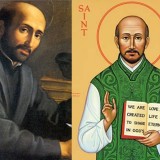Feb 4 2020 Reflection

Tuesday 4 February 2020
First Reading: 2 SM 18:9-10, 14B, 24-25A, 30–19:3
Responsorial Psalm:
Listen, Lord, and answer me.
PS 86:1-2, 3-4, 5-6
Gospel Reading: MK 5:21-43
Today’s Note: Tuesday of the Fourth Week in Ordinary Time
Gospel Reading:
When Jesus had crossed again in the boat
to the other side,
a large crowd gathered around him, and he stayed close to the sea.
One of the synagogue officials, named Jairus, came forward.
Seeing him he fell at his feet and pleaded earnestly with him, saying,
“My daughter is at the point of death.
Please, come lay your hands on her
that she may get well and live.”
He went off with him
and a large crowd followed him.
There was a woman afflicted with hemorrhages for twelve years.
She had suffered greatly at the hands of many doctors
and had spent all that she had.
Yet she was not helped but only grew worse.
She had heard about Jesus and came up behind him in the crowd
and touched his cloak.
She said, “If I but touch his clothes, I shall be cured.”
Immediately her flow of blood dried up.
She felt in her body that she was healed of her affliction.
Jesus, aware at once that power had gone out from him,
turned around in the crowd and asked, “Who has touched my clothes?”
But his disciples said to him,
“You see how the crowd is pressing upon you,
and yet you ask, Who touched me?”
And he looked around to see who had done it.
The woman, realizing what had happened to her,
approached in fear and trembling.
She fell down before Jesus and told him the whole truth.
He said to her, “Daughter, your faith has saved you.
Go in peace and be cured of your affliction.”
While he was still speaking,
people from the synagogue official’s house arrived and said,
“Your daughter has died; why trouble the teacher any longer?”
Disregarding the message that was reported,
Jesus said to the synagogue official,
“Do not be afraid; just have faith.”
He did not allow anyone to accompany him inside
except Peter, James, and John, the brother of James.
When they arrived at the house of the synagogue official,
he caught sight of a commotion,
people weeping and wailing loudly.
So he went in and said to them,
“Why this commotion and weeping?
The child is not dead but asleep.”
And they ridiculed him.
Then he put them all out.
He took along the child’s father and mother
and those who were with him
and entered the room where the child was.
He took the child by the hand and said to her, “Talitha koum,”
which means, “Little girl, I say to you, arise!”
The girl, a child of twelve, arose immediately and walked around.
At that they were utterly astounded.
He gave strict orders that no one should know this
and said that she should be given something to eat.
Reflection:
Do you approach the Lord Jesus with expectant faith or with skeptical doubt? People in desperate or helpless circumstances were not disappointed when they sought Jesus out. What drew them to Jesus? Was it hope for a miracle or a word of comfort in their affliction? What did the elderly woman who had suffered miserably for twelve years expect Jesus to do for her? And what did a grieving father expect Jesus to do for his beloved daughter who was at the point of death? Jesus gave hope where there seemed to be no human cause for it because his hope was directed to God. He spoke words of hope to the woman (Take heart, daughter!) to ignite the spark of faith in her (your faith has made you well!).
Expectant faith believes in Jesus’ power to act in our lives today
Ephrem the Syrian (306-373 AD), an early church Scripture scholar and author of hymns and commentaries, reflected on the miracle of the woman who was healed of her flow of blood:
“Glory to you, hidden Son of God, because your healing power is proclaimed through the hidden suffering of the afflicted woman. Through this woman whom they could see, the witnesses were enabled to behold the divinity that cannot be seen. Through the Son’s own healing power his divinity became known. Through the afflicted women’s being healed her faith was made manifest. She caused him to be proclaimed, and indeed was honored with him. For truth was being proclaimed together with its heralds. If she was a witness to his divinity, he in turn was a witness to her faith… He saw through to her hidden faith, and gave her a visible healing.”
The Lord Jesus will touch each of us with his healing hands of love and mercy
Jesus also gave supernatural hope to a father who had just lost a beloved child. It took considerable courage and risk for the ruler of a synagogue to openly go to Jesus and to invite the scorn of his neighbors and kin. Even the hired mourners laughed scornfully at Jesus. Their grief was devoid of any hope. Nonetheless, Jesus took the girl by the hand and delivered her from the grasp of death. Peter Chrysologus (400-450 AD), an early church father who was renowned for his preaching at Ravena, comments on this miracle:
“This man was a ruler of the synagogue, and versed in the law. He had surely read that while God created all other things by his word, man had been created by the hand of God. He trusted therefore in God that his daughter would be recreated, and restored to life by that same hand which, he knew, had created her… He [Jesus] who laid hands on her to form her from nothing, once more lays hands upon her to reform her from what had perished.”
In both instances we see Jesus’ personal concern for the needs of others and his readiness to heal and restore life. In Jesus we see the infinite love of God extending to each and every individual as he gives freely and wholly of himself to each person he meets. Do you approach the Lord with confident expectation that he will hear your request and act?
“Lord Jesus, you love each of us individually with a unique and personal love. Touch my life with your saving power, heal and restore me to fullness of life. Help me to give wholly of myself in loving service to others.”











